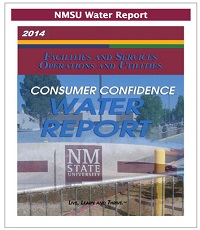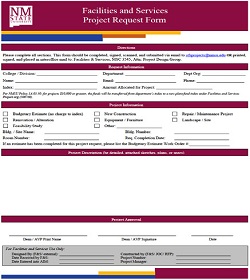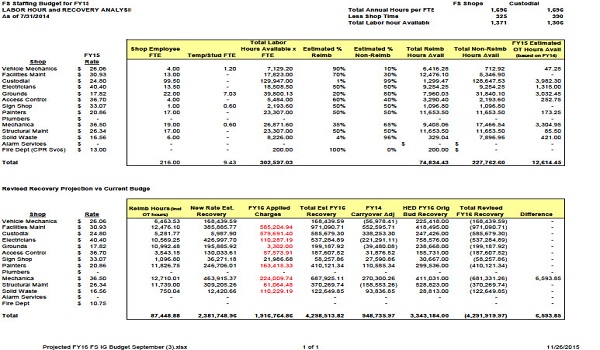6.0 PROCESS MANAGEMENT
EFFECTIVE PROCESS MANAGEMENT ADDRESSES HOW THE FACILITIES ORGANIZATION MANAGES KEY PRODUCT AND SERVICE DESIGN AND DELIVERY PROCESSES. PROCESS MANAGEMENT INCLUDES VARIOUS SYSTEMS SUCH AS WORK MANAGEMENT, PERFORMANCE STANDARDS, ESTIMATING SYSTEMS, PLANNING AND DESIGN OF NEW FACILITIES, AND OTHER KEY PROCESSES THAT AFFECT FACILITIES FUNCTIONS.
- Historical data, customer feedback, management reports, benchmarking results, and anecdotal information (“management‐by‐walking‐around”) will be used to continually evaluate service delivery.
- These processes are continuing; in addition, the Sightlines benchmarking reports provide valuable comparisons with peer institutions.
- The Executive Directors have been developing a minimal number of reports to guide this analysis.
The office and shops are located in a dedicated compound at the edge of campus, and a number of improvements have been made in recent years to improve productivity, synergies, and communications. These have included a relocation of the Mechanical Shop and the Custodial central office, and the reorganization of the utility department to locate technicians closer to their responsibilities and duties at the Central Utility Plant. Project Development and Engineering (PDE) moved from separate groups managing Design and Construction to a methodology known as “concept‐to‐completion” where each Project Manager oversees a project from “cradle‐to‐grave,” and all staff in PDE were relocated into the main building to facilitate collaboration.
Facilities and Services uses the APPA Facilities Performance Indicators (FPI) to measure many activities. While we have had some lively discussions both internally and externally with our friends in APPA as to what the Work Order Hours in Backlog truly represents, we feel that this is “what the customer sees” and thus the time it takes from when the request is made to until the work order is closed is one of the most important measures we have. When we compared this time with “Material On Hand” vs. “Material Not On Hand,” we realized that lead‐time for materials purchases was an area in which significant improvement was needed. As a result, an improvement plan for materials services has been submitted and approved and the materials warehouse was reorganized under Facilities and Services.103
Facilities and Services has developed a Vehicle Replacement Plan and an Equipment Replacement Plan for Grounds, and NMSU has an Equipment Repair and Renewal program. Each Director is responsible for continually evaluating their facilities and equipment to ensure that it is more than adequate for the provision of services.104
-
- The Facilities Condition Assessment module was just implemented in AiM.
- The BRR team met over 12 months to establish the 3‐5 year plan.
Assetworks AiM is the facility management system used by Facilities and Services, and this system gives direct access to faculty, staff, and students on the campus for the reporting of observed maintenance needs. Facilities and Services employees also can submit requests for work to be performed. Environmental Health and Safety conducts laboratory and safety inspections, as does the Fire Department, and they both also report maintenance deficiencies that are entered and tracked with AiM.105
Project level needs are met through Project Development and Engineering. This last year, we completed a multi‐year Building Renewals and Replacements plan that addresses the deficiencies at the building system level. At the highest level, we use the Capital Outlay Process and the Campus Master Plan in conjunction with the Facilities Condition Index (FCI). We recently added the Assessment and Needs Analysis module to AiM to help us track system improvements that lower the FCI.
-
-
- Assetworks AiM has been used for three years now, and we are barely scratching the surface with its capability in this regard. Plans are to send several staff members to other institutions to see what others use for KPIs and reports.
- PDE and Facility Operations have developed a triage process for project requests.
- Facilities and Services maintenance and custodial have been merged with Auxiliaries maintenance and custodial groups. Many processes are being worked through for efficiency.
The Facilities and Services web page allows for customers to decide between a project and a work order request. These always warrant an internal review, and a triage group with designated staff from Facility Operations and Project Development and Engineering meets weekly to make sure that the work is assigned to the appropriate unit.106 Facility Operations regularly reviews an open work order report that helps to make sure that work load is equitably distributed and for outsourcing if any work load is deemed to be excessive. Project Development and Engineering projects are assigned based on a judgment of the balance between dollar value and volume. The business office measures requisitions by individual.107
We have worked hard in Facilities and Services to foster a sense of ownership and that we manage facilities on behalf of the NMSU Board of Regents. We occasionally have politely informed users that their facility requests must be modified before authorization can be provided.
-
-
-
- The new work order system will be used to establish and refine preventative maintenance (PM) procedures. All OFS work groups will have input to the development of the new work order control and PM system. Input from the trades is critical to the establishment of an effective PM program.
- The implementation of the PM program has not been as rapid as previously hoped, but is making progress.
- A PM Coordinator position was created in order to accelerate the full implementation of the PM program.
 NMSU Facilities and Services created and hired a preventative maintenance coordinator position that focuses solely on preventative maintenance. This position works with our information technology support group, Financial Systems Administration (FSA), to refine our preventative maintenance processes. We have implemented fairly sophisticated programs for some of our more critical systems, and the team presented our Water System Preventative Maintenance Program at CAPPA 2014 in El Paso. In order to make sure we comply with our responsibilities as a natural gas Master Meter Operator, we added a special preventative maintenance process for our natural gas distribution system. This past year, we added the campus fume hood assessments to AiM in collaboration with Environmental Health and Safety.108
NMSU Facilities and Services created and hired a preventative maintenance coordinator position that focuses solely on preventative maintenance. This position works with our information technology support group, Financial Systems Administration (FSA), to refine our preventative maintenance processes. We have implemented fairly sophisticated programs for some of our more critical systems, and the team presented our Water System Preventative Maintenance Program at CAPPA 2014 in El Paso. In order to make sure we comply with our responsibilities as a natural gas Master Meter Operator, we added a special preventative maintenance process for our natural gas distribution system. This past year, we added the campus fume hood assessments to AiM in collaboration with Environmental Health and Safety.108
-
-
-
- The project estimating system will be reviewed. A business model using “firm estimates” will be reviewed for applicability at NMSU (this was instituted at the University of North Texas and presented at CAPPA).
- An estimator has been selected and hired, and changes have been implemented in the process for consistent estimates. RSMEANS training will be conducted.
- An estimating program was added to AiM.
Project Development and Engineering (PDE) has an estimator, and Facilities and Services has implemented a standardized process that provides budgetary estimates to faculty and staff at NMSU. A Project Request Form requesting a budgetary estimate is submitted to Facilities and Services, and this document is then routed through the triage process.109
The triage process consists of a group of staff representing different departments within Facilities and Services that decides on how the project requests will be distributed. Some of the considerations are dollar amount for capitalization, number of trades involved, workload distribution, and permitting requirements. We strive to be able to complete requests as expeditiously and efficiently as possible, and the Facility Operations shops can move quickly on the small scale renovations if the appropriate conditions are in place, the needs are well defined, and the work load permits. When the project is assigned to Facility Operations, the shops may prepare the budget, however, an estimate is prepared for all billable work.
When assigned to PDE, a project manager contacts and meets with the customer to determine the exact nature of the work being requested, inspects the area where the work will be completed, and obtains any additional information pertinent to providing an accurate budgetary estimate. Once this step is completed, the project manager meets and provides the estimator with the scope of work, drawings, and any other necessary information needed for compiling the estimate. Under certain circumstances, the person meeting with the customer will compile the estimate.
A budgetary estimate is then prepared using the methods described. Once the estimate is completed, the estimator meets with the project manager, reviews the estimate, and answers any questions. The project manager then meets with the customer, explains the estimate, and responds to any questions. Once this process is complete, the estimate is filed electronically in a PDE file and in AiM for future reference.
A 3rd party estimator working directly for NMSU is generally employed on capital projects.
PDE has compared the difference between the estimated costs and actual costs, and while we have some ideas and theories about the differences, we have not fully implemented an analytical process for determining the cause for the deviations.
-
-
- The design guidelines will be reviewed with OFPC and updated when necessary to accurately reflect OFS and NMSU requirements. Life cycle cost analysis will be emphasized.
- The first draft of the Design Guidelines has been published, and revisions are in progress.
- The Design Guidelines are being used on all large projects.
- A review of the Design Guidelines is in progress.
The Facilities and Services Design Guidelines calls out our preferences in order to assist the architects, engineers, and commissioning agents in the construction process. Our four volumes of Design Guidelines and supporting documentation are listed on our web page, and are maintained with input from all staff in Facilities and Services.110 The Design Guidelines include drawing details and specifications to address maintainability, and the Sustainability Manager and Environmental Health and Safety (EHS) staff are involved in the project planning and review process, although the role of EHS in large construction projects is carefully defined so as to maintain accountability by the contractor. NMSU builds to meet or exceed LEED Silver, although this is also a state requirement.
- Accountability will be developed for Directors and Supervisors by requesting their input early in the budget cycle and through regular budget reviews.
- Monthly and quarterly budget reports and presentations are conducted, and Facilities and Services has been slightly under budget each year.
- An annual unit budget presentation and subsequent reallocation request that encourages efficient use of resources has been developed.
- Monthly reviews have had the impact we hoped for, as FS consistently comes in under budget and is accelerating the BRR expenditures.
The business office has regular meetings with the staff at the supervisory level. Ours is a complex budget with a significant recovery burden that detracts from the focus on core activities, but we have been able to reduce this “recharge” burden in a manner that corresponds to our reduction in positions over two budget cuts, thus increasing our focus on maintenance.
Project Development and Engineering moved from separate and distinct phases of design and construction to the “concept‐to‐completion” model, and each project manager has complete autonomy over the project budget. The business office tracks change orders and the reasons for them, and these may be used when considering the performance of the design professionals in the next Request for Proposal scoring process.
The utilities services center meets periodically with the Auxiliaries units such as Special Events, Corbett Student Union, and Residential Housing to review utility invoices and make sure that there are no surprises at year‐end. The Fire Department is partially funded by Doña Ana County, and is routinely successful in obtaining grants from the County Fire Fund. In mid‐November, the Fire Department received a $100,000 grant. Despite the fact that hazardous material disposal costs have increased substantially over the past three years, and the budget for this cost has been reduced, Environmental Health and Safety continues to meet budget.
All units have been within budget for a number of years now, and we have established the culture of wringing every last dollar out of our available budget. In addition, the Associate Vice Presidents of Facilities at NMSU and at the University of North Texas have joined together on an APPA CFaR research project that will study “Recovery and Recharge” as a financing and budgeting mechanism for institutional facilities management. This past year, we consolidated the Corbett Student Union and Residential Housing custodial and maintenance staff with ours. The year before, we assumed the custodial duties from Athletics. Stringent budget monitoring has been required to make sure that these Service Level Agreements have the desired positive impact on the Facilities and Services, Athletics, and Auxiliary budgets.111


